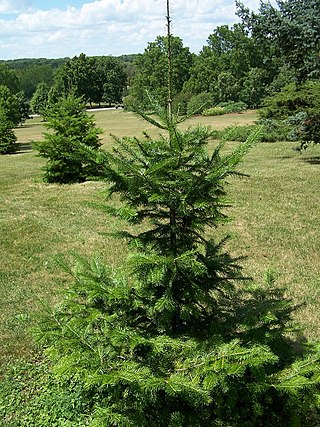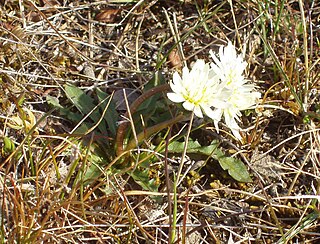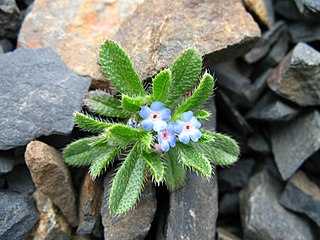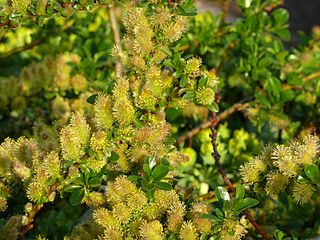
Medicago is a genus of flowering plants, commonly known as medick or burclover, in the legume family (Fabaceae). It contains at least 87 species and is distributed mainly around the Mediterranean Basin, and extending across temperate Eurasia and sub-Saharan Africa. The best-known member of the genus is alfalfa, an important forage crop, and the genus name is based on the Latin name for that plant, medica, from Greek: μηδική (πόα) Median (grass). Most members of the genus are low, creeping herbs, resembling clover, but with burs. However, alfalfa grows to a height of 1 meter, and tree medick is a shrub. Members of the genus are known to produce bioactive compounds such as medicarpin and medicagenic acid. Chromosome numbers in Medicago range from 2n = 14 to 48.

Isatis is a genus of flowering plants in the family Brassicaceae, native to the Mediterranean region east to central Asia. Its genus name, Isatis, derives from the ancient Greek word for the plant, ἰσάτις. The genus includes woad. Due to their extremely variable morphology, the Asian species in particular are difficult to determine; the only reliable diagnostic feature is the ripe fruit. They are (usually) biennial or perennial herbaceous plants, often bluish and hairless or downy hairy with the upright stem branched.

Pentaglottis is a monotypic genus of flowering plants in the family Boraginaceae. It is represented by a single species, Pentaglottis sempervirens, commonly known as the green alkanet, evergreen bugloss or alkanet, and is a bristly, perennial plant native to southwestern Europe, in northwest Iberia and France.

Abies nephrolepis, commonly known as Khingan fir, is a species of fir native to northeastern China, North Korea, South Korea, and southeastern Russia.

Anemonoides is a genus of flowering plants in the buttercup family Ranunculaceae. Plants of the genus are native to the temperate regions of the Northern Hemisphere, on the continents of North America, Europe, and Asia. The generic name Anemonoides means "anemone-like", a reminder that many of the species were formerly included within the genus Anemone.
Laser is a genus of flowering plant in the family Apiaceae, native from Europe to northern Iran. The genus was first described in 1799.

Bellardiochloa is a genus of flowering plants in the grass family Poaceae. It is native to Europe and western Asia.

Stipa tirsa is a species of perennial grass native to Europe and temperate Asia. Culms are 40–100 cm long; leaf blades are filiform, involute, and 1–2 mm wide.
Carex appendiculata is a species of sedge. It is native to northern and eastern Asia and New Guinea.

Juncus inflexus, the hard rush, is a species of flowering plant in the family Juncaceae, native to Europe, Asia and Africa, and introduced in Sri Lanka, Java, Île Amsterdam and Île Saint-Paul, Victoria in Australia, New Zealand, Uruguay, and eastern North America. It is a glycophyte (non-halophyte).

Betula costata is a species of tree belonging to the family Betulaceae.

Taraxacum arcticum, the arctic dandelion, is a species of flowering plant belonging to the family Asteraceae. Its native range is Greenland, Northern Europe, Northern Asia and the Northern Russian Far East.
Ranunculus schmalhausenii is a species of flowering plant belonging to the family Ranunculaceae.

Trigonocaryum is a genus of flowering plants belonging to the family Boraginaceae.

Cymatocarpus is a genus of flowering plants belonging to the family Brassicaceae.
Pseudocherleria is a genus of flowering plants belonging to the family Caryophyllaceae.

Rhododendron smirnowii, the Smirnow rhododendron, is a species of flowering plant in the family Ericaceae, native to northeast Turkey and the western Transcaucasus. In its native habitat it is found up to 2,300 m (7,500 ft) in elevation, and in cultivation is hardy to USDA zone 5 with some protection. Its cultivar 'Vodka' gained the Royal Horticultural Society's Award of Merit in 1991.

Echinops chantavicus is a species of flowering plant in the genus Echinops, native to Central Asia.

Symphytum grandiflorum, the creeping comfrey, or running comfrey is a species of flowering plant in the family Boraginaceae. It is native to the Caucasus region, and introduced to various locales in Europe as a garden escapee. A deer-tolerant perennial, it is hardy in USDA zones 5 through 8, and is recommended for borders and shady situations. The unimproved species and a number of cultivars are commercially available. Also, it has been crossed with Russian comfrey to produce the multi-cross hybrid Hidcote comfrey, of which a range of ornamental cultivars are available.

Salix apoda, the Caucasian willow, is a species of flowering plant in the family Salicaceae, native to the Caucasus and northern Turkey. A prostrate shrub, it is occasionally cultivated as an ornamental ground cover in rock gardens, particularly the males, since they produce large, silvery catkins that then erupt in yellow stamens.















